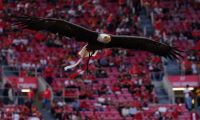
The Chevrolet Bel Air was a full-size car produced by Chevrolet for the 1950–1981 model years. Initially only the two door hardtops in the Chevrolet model range were designated with the Bel Air name from 1950 to 1952, as distinct from the Styleline and Fleetline models for the remainder of the range. With the 1953 model year the Bel Air name was changed from a designation for a unique body shape to a premium level of trim applied across a number of body styles. The Bel Air continued with various other trim level designations until US production ceased in 1975. Production continued in Canada, for its home market only, through the 1981 model year.
For 1955, Chevrolet's full-size model received all new styling and power. The 1955 Bel Air was 3,456 lb (1,568 kg) and 15 ft (4.6 m) long. It was called the "Hot One" in GM's advertising campaign. Chevrolet's styling was crisp, clean and incorporated a Ferrari-inspired grille. Bel Airs came with features found on cars in the lower models ranges plus interior carpet, chrome headliner bands on hardtops, chrome spears on front fenders, stainless steel window moldings, and full wheel covers. Models were further distinguished by the Bel Air name script in gold lettering later in the year.
For 1955 Chevrolets gained a V8 engine option and the option of the 2 speed Powerglide automatic, or a standard three speed Synchro-Mesh manual transmission with optional overdrive. The new 265 cu in (4.3 L) V8 featured a modern, overhead valve high compression ratio, short stroke design that was so good that it remained in production in various displacements for many decades. The base V8 had a two-barrel carburetor and was rated at 162 hp (121 kW) and the "Power Pack" option featured a four-barrel carburetor and other upgrades yielding 180 bhp (134 kW). Later in the year, a "Super Power Pack" option added high-compression and a further 15 bhp (11 kW). "Idiot" lights replaced gauges for the generator and oil pressure.
This was not the first Chevrolet to be installed with a V8 engine. The first Chevrolet with a V8 engine was introduced in 1917 called the Series D which was built for two years, and was manufactured before Chevrolet joined General Motors.
Motor Trend magazine gave the Bel Air top marks for handling.
Popular Mechanics reported acceleration for a V8 Bel Air with Powerglide as being 0-60 mph (97 km/h) in 12.9 seconds, plus a comfortable ride and good visibility. On the other hand, the horn ring blocked some of the speedometer, regular gasoline made the engine knock and the first V8 engines off the line burned too much oil.
Front legroom was 43.1".[1] Brakes were 11" drums.
A new option for V8-equipped 1955 models was air conditioning, with outlets on each side of the dashboard; a heavy-duty generator was included on cars equipped with this option; in 1955 and 1956, air conditioning could be installed on cars ordered with the standard three-speed manual transmission, overdrive or Powerglide, but from 1957 onward, an automatic transmission (or minus that, 4-speed manual transmission) was a pre-requisite option.
The 1956 Bel Air received a face-lift with a more conventional full-width grille, pleasing those customers who didn't favor the Ferrari-inspired '55 front end. Distinctive two-tone bodyside treatments and graceful front and rear wheel openings completed the "speedline" restyling. Single housings incorporated the taillight, stoplight, and backup light, and the left one held the gas filler - an idea popularized on Cadillacs. Among the seven Bel Air models was a new Sport Sedan, a pillarless four-door hardtop that looked handsome with all the windows rolled down and allowed easy entry into the back seat. Production exceeded 103,000, compared to 128,000 two-door hardtops. Shapely two-door Nomad wagons topped the price chart at $2,608, but now carried the same interior and rear-wheel sheetmetal as other Bel Airs, lacking the original's unique trim. Only 7,886 were built.
The least costly Bel Air, at $2,025, was the two-door sedan. Seatbelts, shoulder harnesses, and a padded dashboard were available, and full-size cars could even get the hot Corvette 225-horsepower engine. In 1956 sales material there was an optional rain-sensing automatic top,[13] which was first seen on the 1951 LaSabre concept car. However, it is believed that it was never installed on a car.[14] Popular Mechanics reported only 7.4% of owners in their survey ordered seat belts. A '56 Bel Air 4-door hardtop, prepared by Chevy engineer Zora Arkus Duntov, set a new endurance/speed record for an automobile ascending Pikes Peak.
In 1957 engine displacement grew to 283 cu in (4.6 L) with the "Super Turbo Fire V8" option (shared with the Corvette), producing 283 hp (287 PS; 211 kW) @ 6200 rpm and 290 lb⋅ft (393 N⋅m) @ 4400 rpm of torque[15] with the help of Rochester Ramjet[16] continuous mechanical fuel injection (closed-loop).
These so-called "fuelie" cars are quite rare, since most Bel Airs were fitted with carburetion.
The 1957 Bel Air is considered by many to be "an icon of its age. . .right alongside Elvis, Marilyn Monroe, and Leave it to Beaver," and is among the most recognizable American cars of all time; well-maintained examples, especially Sport Coupes and Convertibles are highly sought after by collectors and enthusiasts. They are roomy, with tastefully restrained, period use tail fins and chrome. A second automatic transmission, Turboglide was optional. While the original two-speed Powerglide continued unchanged, Turboglide provided a continuously variable gear-ratio which made "shifting" imperceptible. The shift quadrant on Turboglide cars followed a "P R N D Gr" pattern.
From 1955 to 1957, production of the two-door Nomad station wagon was assigned to the Bel Air series, although its body and trim were unique to that model. Prior to becoming a regular production model, the Nomad first appeared as a Corvette-based concept vehicle in 1954. Chevrolet has since unveiled two concept cars bearing the Nomad name, most recently in 1999. The 1955–1957 Chevrolets are commonly referred to as Tri Fives.
The 1955-1957s were made in right-hand drive and shipped from Oshawa, Canada, for local assembly in Australia (CKD), New Zealand (SKD) and South Africa. All three model years had a reversed version of the '55 LHD dashboard and did not get the LHD models' 1957 redesign.
A black 1955 Chevrolet Bel Air was featured in the 1973 movie American Graffiti. In the movie, the car is driven by the character Bob Falfa, played by Harrison Ford. The 55" features a big hood scoop, and a signature cowboy hat in the rear window. The 55" races against a yellow 1932 Ford Deuce Coupe, and crashes into a ditch. The Bel Air had a 454 cubic inch chevrolet motor, with aluminum heads, tunnel ram intake and dual Holley carburetors.












































 LINKS E SITES IMPORTANTES
LINKS E SITES IMPORTANTES


